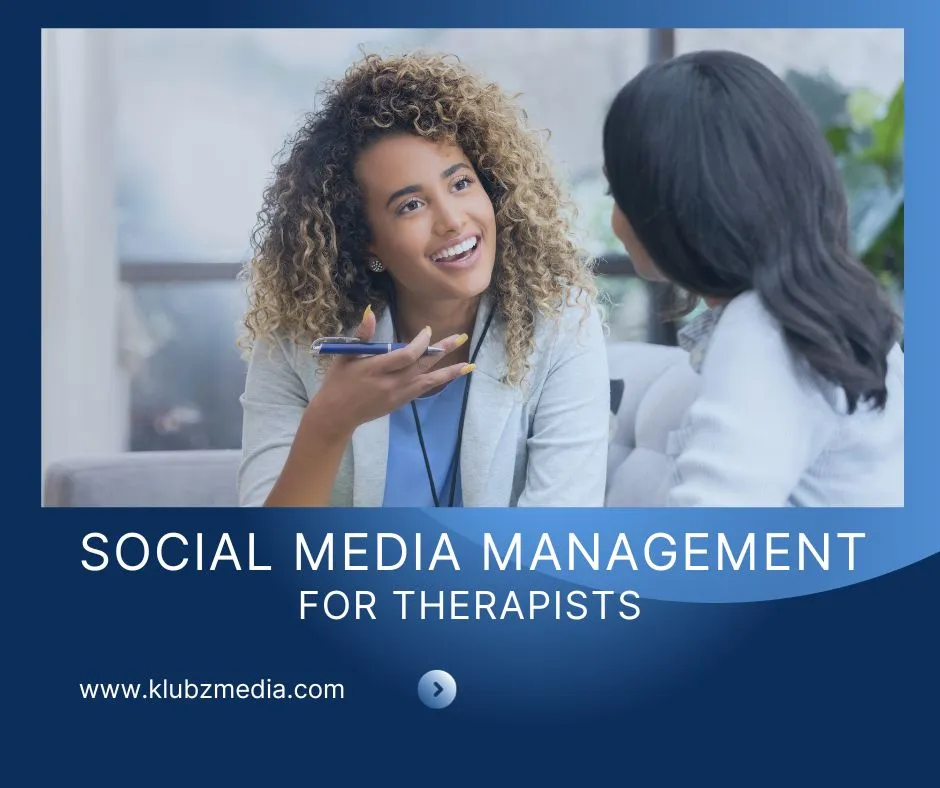A therapist’s typical day revolves around helping people feel better emotionally. They focus on understanding the complexities of the human mind and offer support to those striving for emotional harmony. Social media management for therapists is the strategic use of social media platforms to build brand awareness, attract potential clients, and engage with current clients in a way that adheres to ethical guidelines.
As a therapist, social media can be helpful for you to reach more people than just those in your office. Additionally, you can share mental health info, challenge stereotypes, and offer coping tips through blogs and posts. By leveraging the use of social media, you will be helping those who might not seek therapy otherwise. It will make mental health conversations more accessible.
A report by mental health America claimed, 64% of Americans with mental illness report experiencing stigma. Even in 2024, we still have a stigma where people are not comfortable to talk about mental health publicly. As a result, many of us are not open to see therapists. Here is the golden chance for you to break the stigma by using social media. With 4.55 billion social media users worldwide, you can spread the voice mental health at every corner.
Social Media Management for Therapist

This blog aims to be a handbook of social media management for therapists. Here we have all details about how can therapists use Facebook and Instagram to share their knowledge and help people looking for support. Keep reading!
Step 1: Selecting the Right Social Media Platforms
Selecting the right social media platforms is crucial for therapists to effectively connect with their audience. Each platform serves a unique purpose and reaches different demographics.
1. Facebook: Connecting with a 2.8B Broad Audience
Facebook is ideal for reaching a diverse audience. It allows you to share a mix of content, from informative articles to interactive polls. You can create groups for discussions, fostering a sense of community. It’s also great for event promotion and client testimonials.
2. Instagram: Leveraging Visual Content
Instagram’s visual nature is perfect for sharing inspirational quotes, infographics, and short videos. You can use Instagram Stories for quick tips or to give a glimpse into their professional life. Hashtags can increase visibility, helping to attract a wider, yet targeted, audience.
3. LinkedIn: Networking with Professionals
LinkedIn is a professional network where you can connect with colleagues, join industry groups, and share their expertise through articles and posts. It’s an excellent platform for building professional credibility. Also, it enables you to discuss more in-depth topics related to mental health.
4. Twitter ( X ): Engaging in Quick, Impactful Conversations
Twitter ( X )’s fast-paced environment is ideal for sharing brief insights. You can also link to relevant articles, and participating in trending mental health conversations. This platform is helpful for quick engagements.
5. YouTube: Sharing In-Depth Video Content
YouTube allows you to create longer-form content. For example, detailed explanations of therapy techniques, interviews, or educational series. It’s a powerful tool for building a deeper connections. You can talk to you audiences directly. People who are seeking mental concerns are able to hear from you , see you and be guided what to do next.
Step 2: Creating Engaging Content
The niche of mental health content is quite lucrative. It’s a regular day need. The contents have broader spectrum than just being published for the sake of someone to read. The contents of therapists should be inspiring. The objective is to make an impact on those who are in need. So, we have shortlisted some topics you may want to consider.
1. Types of Content
Content can be categorized into three main types: Educational, Inspirational, and Interactive. Educational content may include mental wellness tips, therapy technique explanations, or insights into mental health trends. Inspirational content encompasses success stories, motivational quotes, and client journeys. Interactive content involves Q&A sessions, polls, or quizzes to actively engage the audience. You can also add common misconceptions about therapy or mental health.
2. Balancing Professional and Personal Tone
Therapists need to be professional to follow rules and gain trust. But adding a personal touch helps people relate better. Finding this balance makes a space where people feel understood, supported, and keeps the therapist-client relationship professional.
3. Using Multimedia: Images, Videos, and Text
You can use pictures, charts, and videos to make their messages more interesting. These visuals help explain complicated ideas . It also makes things easier to understand. Adding these visual elements makes learning about mental health more fun and accessible for everyone. You can leverage multimedia to create a more interactive and visually appealing experience for you audience.
4. Content Planning and Scheduling
Effective content planning and scheduling ensure a consistent online presence. When the audiences find you available on social platforms regularly, it enhances their reliability.
At Klubz Media, experts understand that using one consistent voice for both your audience and brand helps build strong and lasting connections with patients.
Step 3: Building and Maintaining Professionalism Online
Therapists need to be just as professional online as they are in person. This helps maintain a consistent and trustworthy image when interacting with clients or the public.
- Ethical Considerations and Privacy: Always adhere to ethical guidelines, especially regarding client confidentiality and privacy. Avoid sharing any identifiable client information. Ensure your social media content aligns with professional standards and reflects the values of your practice.
- Managing Personal vs. Professional Profiles: Keep personal and professional profiles separate. Use professional accounts for sharing therapy-related content and engaging with clients or colleagues.
- Responding to Comments and Messages: Engage with your audience professionally when responding to comments and messages.
Step 4: Growing Your Practice Through Social Media
Make your therapy sessions available online. Social media will help you to connect people beyond your region. It will grow your practice are and bring you collective experience.
1. Strategies for Increasing Followers and Engagement
Initially, focus on creating and sharing content that resonates with your target audience. Once you start, it will automatically increase both follower count and engagement. Regularly post insightful articles, interactive polls, and relatable stories. You can significantly boost your online presence.
2. Collaborating with Influencers and Other Professionals
Moreover, teaming up with influencers and professionals in the mental health field can extend your reach. These partnerships, through shared content or events, introduce your practice to broader audiences.
3. Paid Advertising: When and How to Use It Effectively
Lastly, for targeted growth, consider paid advertising. At Klubz Media, we offer specialized social media management services. We can help tailor your advertising campaigns to effectively reach and engage potential clients. We ensure that your investment yields tangible results.
Step 5: Measuring Social Media Success
The last step is to regularly check whether your social media strategies are working or not. Always do A/B testing and upgrade strategies based on audience’s need.
- Tools and Metrics for Tracking Performance: Utilize tools like Google Analytics and social media platform insights to monitor key metrics such as reach, engagement rates, and click-throughs. These tools provide a comprehensive view of your performance, guiding your future content strategy.
- Analyzing Engagement and Audience Growth: Examine how your audience interacts with your content. Look for trends in likes, shares, comments, and new followers to understand what resonates with your audience.
- Adjusting Strategies Based on Analytics: Based on these insights, adjust your strategies. If certain types of posts get more engagement, focus on similar content.
For expert assistance in analytics and strategy adjustment, consider outsourcing social media management services, which specialize in social media management and can help optimize your online presence for maximum impact.
Future Trends in Social Media for Therapists

As new platforms like TikTok and VR spaces emerge, therapists must evolve their social strategies to engage Gen Z. Staying atop frequently changing algorithms and heightening video usage will be key to reaching wider audiences.
Geotagging in Stories and live chat bots allow for more convenient access to support. By leveraging AI and niche communities, you can nurture personalized connections rooted in compassion.
FAQs
How Can Therapists Use Social Media?
Therapists use social media to share educational content, engage with their community, and market their services. It’s a tool for outreach and building professional networks.
What Is the Most Recommended Practice for Therapists Using Social Media?
The best practice is maintaining client confidentiality, separating personal and professional accounts, and sharing general, informative content that adheres to ethical guidelines.
What Is the Main Challenge of Therapists Using Social Media?
The primary challenge is balancing professional boundaries while engaging online, especially maintaining confidentiality and navigating dual relationships with clients.
Do Therapists Look at Clients’ Social Media?
Generally, therapists avoid viewing clients’ social media to maintain professional boundaries and avoid influencing the therapeutic relationship with outside information.
Final Thoughts
Social media managements for therapists open a dynamic opportunity to educate, engage, and expand practices. Share helpful mental health info and create a supportive online community where meaningful conversations can take place. Make your voice louder to those who need you the most. Contact us if you need any assistance with your social media services.


